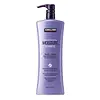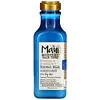What's inside
What's inside
 Key Ingredients
Key Ingredients

No key ingredients
 Benefits
Benefits

 Concerns
Concerns

 Ingredients Side-by-side
Ingredients Side-by-side

Water
Skin ConditioningSodium Cocoyl Isethionate
CleansingCocamidopropyl Hydroxysultaine
CleansingPotassium Cocoyl Glycinate
Disodium Cocoyl Glutamate
CleansingSodium Lauroyl Methyl Isethionate
CleansingSodium Lauroyl Sarcosinate
CleansingDecyl Glucoside
CleansingPotassium Cocoate
EmulsifyingGlycereth-26
HumectantGlycol Distearate
EmollientCocamidopropylamine Oxide
CleansingPhenoxyethanol
PreservativeParfum
MaskingSodium Cocoyl Glutamate
CleansingPEG-120 Methyl Glucose Dioleate
EmulsifyingMethyl Gluceth-20
HumectantQuaternium-91
Amodimethicone
Acrylates Copolymer
Citric Acid
BufferingDicaprylyl Ether
EmollientPolyquaternium-10
Guar Hydroxypropyltrimonium Chloride
Skin ConditioningChlorphenesin
AntimicrobialTrisodium Ethylenediamine Disuccinate
PPG-3 Benzyl Ether Myristate
EmollientGlyceryl Oleate
EmollientC11-15 Pareth-7
EmulsifyingPolyquaternium-39
Laureth-9
EmulsifyingPhospholipids
Skin ConditioningGlycerin
HumectantHydrolyzed Vegetable Protein Pg-Propyl Silanetriol
Skin ConditioningPolyquaternium-55
Sodium Benzoate
MaskingPanthenol
Skin ConditioningTrideceth-12
EmulsifyingGlycine Soja Oil
EmollientAcetic Acid
BufferingTetrasodium EDTA
Benzoic Acid
MaskingSodium Hydroxide
BufferingDisodium EDTA
Potassium Sorbate
PreservativeHydrolyzed Pea Protein Pg-Propyl Silanetriol
Skin ConditioningCaprylyl Glycol
EmollientTocopheryl Acetate
AntioxidantHelianthus Annuus Seed Oil
EmollientAlcohol
AntimicrobialTocopherol
AntioxidantArgania Spinosa Kernel Oil
EmollientAscorbic Acid
AntioxidantPersea Gratissima Oil
Skin ConditioningCopaifera Officinalis Resin
MaskingPassiflora Edulis Seed Oil
EmollientIsomalt
HumectantEuterpe Oleracea Fruit Oil
Skin ConditioningAloe Barbadensis Leaf Extract
EmollientCucumis Sativus Fruit Extract
EmollientLycium Barbarum Fruit Extract
AstringentPunica Granatum Extract
AstringentMalus Domestica Fruit Cell Culture Extract
Skin ConditioningQuaternium-95
UV AbsorberPropanediol
SolventCamellia Sinensis Leaf Extract
AntimicrobialPersea Gratissima Fruit Extract
EmollientXanthan Gum
EmulsifyingLecithin
EmollientVitis Vinifera Fruit Cell Extract
Skin ConditioningVitis Vinifera Seed Extract
AntimicrobialPentaerythrityl Tetra-Di-T-Butyl Hydroxyhydrocinnamate
AntioxidantWater, Sodium Cocoyl Isethionate, Cocamidopropyl Hydroxysultaine, Potassium Cocoyl Glycinate, Disodium Cocoyl Glutamate, Sodium Lauroyl Methyl Isethionate, Sodium Lauroyl Sarcosinate, Decyl Glucoside, Potassium Cocoate, Glycereth-26, Glycol Distearate, Cocamidopropylamine Oxide, Phenoxyethanol, Parfum, Sodium Cocoyl Glutamate, PEG-120 Methyl Glucose Dioleate, Methyl Gluceth-20, Quaternium-91, Amodimethicone, Acrylates Copolymer, Citric Acid, Dicaprylyl Ether, Polyquaternium-10, Guar Hydroxypropyltrimonium Chloride, Chlorphenesin, Trisodium Ethylenediamine Disuccinate, PPG-3 Benzyl Ether Myristate, Glyceryl Oleate, C11-15 Pareth-7, Polyquaternium-39, Laureth-9, Phospholipids, Glycerin, Hydrolyzed Vegetable Protein Pg-Propyl Silanetriol, Polyquaternium-55, Sodium Benzoate, Panthenol, Trideceth-12, Glycine Soja Oil, Acetic Acid, Tetrasodium EDTA, Benzoic Acid, Sodium Hydroxide, Disodium EDTA, Potassium Sorbate, Hydrolyzed Pea Protein Pg-Propyl Silanetriol, Caprylyl Glycol, Tocopheryl Acetate, Helianthus Annuus Seed Oil, Alcohol, Tocopherol, Argania Spinosa Kernel Oil, Ascorbic Acid, Persea Gratissima Oil, Copaifera Officinalis Resin, Passiflora Edulis Seed Oil, Isomalt, Euterpe Oleracea Fruit Oil, Aloe Barbadensis Leaf Extract, Cucumis Sativus Fruit Extract, Lycium Barbarum Fruit Extract, Punica Granatum Extract, Malus Domestica Fruit Cell Culture Extract, Quaternium-95, Propanediol, Camellia Sinensis Leaf Extract, Persea Gratissima Fruit Extract, Xanthan Gum, Lecithin, Vitis Vinifera Fruit Cell Extract, Vitis Vinifera Seed Extract, Pentaerythrityl Tetra-Di-T-Butyl Hydroxyhydrocinnamate
Aloe Barbadensis Leaf Juice
Skin ConditioningWater
Skin ConditioningCetearyl Alcohol
EmollientBehentrimonium Chloride
PreservativeCetyl Alcohol
EmollientGlycerin
HumectantSteareth-20
CleansingCocos Nucifera Fruit Extract
EmollientPsidium Guajava Fruit Extract
AstringentMangifera Indica Seed Butter
Skin ConditioningCocos Nucifera Water
MaskingCocos Nucifera Oil
MaskingIsostearyl Hydroxystearate
EmollientStearamidopropyl Dimethylamine
EmulsifyingIsopropyl Myristate
EmollientDicaprylyl Carbonate
EmollientPanthenol
Skin ConditioningPolyquaternium-37
Polyquaternium-10
PPG-1 Trideceth-6
Skin ConditioningPropylene Glycol Dicaprylate/Dicaprate
EmollientIsopropyl Alcohol
SolventCitric Acid
BufferingSodium Hydroxide
BufferingSodium Benzoate
MaskingParfum
MaskingAloe Barbadensis Leaf Juice, Water, Cetearyl Alcohol, Behentrimonium Chloride, Cetyl Alcohol, Glycerin, Steareth-20, Cocos Nucifera Fruit Extract, Psidium Guajava Fruit Extract, Mangifera Indica Seed Butter, Cocos Nucifera Water, Cocos Nucifera Oil, Isostearyl Hydroxystearate, Stearamidopropyl Dimethylamine, Isopropyl Myristate, Dicaprylyl Carbonate, Panthenol, Polyquaternium-37, Polyquaternium-10, PPG-1 Trideceth-6, Propylene Glycol Dicaprylate/Dicaprate, Isopropyl Alcohol, Citric Acid, Sodium Hydroxide, Sodium Benzoate, Parfum
 Reviews
Reviews

Ingredients Explained
These ingredients are found in both products.
Ingredients higher up in an ingredient list are typically present in a larger amount.
Citric Acid is an alpha hydroxy acid (AHA) naturally found in citrus fruits like oranges, lemons, and limes.
Like other AHAs, citric acid can exfoliate skin by breaking down the bonds that hold dead skin cells together. This helps reveal smoother and brighter skin underneath.
However, this exfoliating effect only happens at high concentrations (20%) which can be hard to find in cosmetic products.
Due to this, citric acid is usually included in small amounts as a pH adjuster. This helps keep products slightly more acidic and compatible with skin's natural pH.
In skincare formulas, citric acid can:
While it can provide some skin benefits, research shows lactic acid and glycolic acid are generally more effective and less irritating exfoliants.
Most citric acid used in skincare today is made by fermenting sugars (usually from molasses). This synthetic version is identical to the natural citrus form but easier to stabilize and use in formulations.
Read more about some other popular AHA's here:
Learn more about Citric AcidGlycerin is already naturally found in your skin. It helps moisturize and protect your skin.
A study from 2016 found glycerin to be more effective as a humectant than AHAs and hyaluronic acid.
As a humectant, it helps the skin stay hydrated by pulling moisture to your skin. The low molecular weight of glycerin allows it to pull moisture into the deeper layers of your skin.
Hydrated skin improves your skin barrier; Your skin barrier helps protect against irritants and bacteria.
Glycerin has also been found to have antimicrobial and antiviral properties. Due to these properties, glycerin is often used in wound and burn treatments.
In cosmetics, glycerin is usually derived from plants such as soybean or palm. However, it can also be sourced from animals, such as tallow or animal fat.
This ingredient is organic, colorless, odorless, and non-toxic.
Glycerin is the name for this ingredient in American English. British English uses Glycerol/Glycerine.
Learn more about GlycerinPanthenol is a common ingredient that helps hydrate and soothe the skin. It is found naturally in our skin and hair.
There are two forms of panthenol: D and L.
D-panthenol is also known as dexpanthenol. Most cosmetics use dexpanthenol or a mixture of D and L-panthenol.
Panthenol is famous due to its ability to go deeper into the skin's layers. Using this ingredient has numerous pros (and no cons):
Like hyaluronic acid, panthenol is a humectant. Humectants are able to bind and hold large amounts of water to keep skin hydrated.
This ingredient works well for wound healing. It works by increasing tissue in the wound and helps close open wounds.
Once oxidized, panthenol converts to pantothenic acid. Panthothenic acid is found in all living cells.
This ingredient is also referred to as pro-vitamin B5.
Learn more about PanthenolParfum is a catch-all term for an ingredient or more that is used to give a scent to products.
Also called "fragrance", this ingredient can be a blend of hundreds of chemicals or plant oils. This means every product with "fragrance" or "parfum" in the ingredients list is a different mixture.
For instance, Habanolide is a proprietary trade name for a specific aroma chemical. When used as a fragrance ingredient in cosmetics, most aroma chemicals fall under the broad labeling category of “FRAGRANCE” or “PARFUM” according to EU and US regulations.
The term 'parfum' or 'fragrance' is not regulated in many countries. In many cases, it is up to the brand to define this term.
For instance, many brands choose to label themselves as "fragrance-free" because they are not using synthetic fragrances. However, their products may still contain ingredients such as essential oils that are considered a fragrance by INCI standards.
One example is Calendula flower extract. Calendula is an essential oil that still imparts a scent or 'fragrance'.
Depending on the blend, the ingredients in the mixture can cause allergies and sensitivities on the skin. Some ingredients that are known EU allergens include linalool and citronellol.
Parfum can also be used to mask or cover an unpleasant scent.
The bottom line is: not all fragrances/parfum/ingredients are created equally. If you are worried about fragrances, we recommend taking a closer look at an ingredient. And of course, we always recommend speaking with a professional.
Learn more about ParfumPolyquaternium-10 is an ammonium salt of hydroxyethylcellulose. It is a white and granular powder used as a film-former and anti-static agent.
This ingredient is commonly found in hair conditioning products. According to a manufacturer, its positive charge makes it great for absorbing hair proteins. The manufacturer also states this ingredient helps with curl retention.
For haircare friends: this ingredient is not a silicone.
Learn more about Polyquaternium-10Sodium Benzoate is a preservative. It's used in both cosmetic and food products to inhibit the growth of mold and bacteria. It is typically produced synthetically.
Both the US FDA and EU Health Committee have approved the use of sodium benzoate. In the US, levels of 0.1% (of the total product) are allowed.
Sodium benzoate works as a preservative by inhibiting the growth of bacteria inside of cells. It prevents the cell from fermenting a type of sugar using an enzyme called phosphofructokinase.
It is the salt of benzoic acid. Foods containing sodium benzoate include soda, salad dressings, condiments, fruit juices, wines, and snack foods.
Studies for using ascorbic acid and sodium benzoate in cosmetics are lacking, especially in skincare routines with multiple steps.
We always recommend speaking with a professional, such as a dermatologist, if you have any concerns.
Learn more about Sodium BenzoateSodium Hydroxide is also known as lye or caustic soda. It is used to adjust the pH of products; many ingredients require a specific pH to be effective.
In small amounts, sodium hydroxide is considered safe to use. However, large amounts may cause chemical burns due to its high alkaline.
Your skin has a natural pH and acid mantle. This acid mantle helps prevent harmful bacteria from breaking through. The acid mantle also helps keep your skin hydrated.
"Alkaline" refers to a high pH level. A low pH level would be considered acidic.
Learn more about Sodium HydroxideWater. It's the most common cosmetic ingredient of all. You'll usually see it at the top of ingredient lists, meaning that it makes up the largest part of the product.
So why is it so popular? Water most often acts as a solvent - this means that it helps dissolve other ingredients into the formulation.
You'll also recognize water as that liquid we all need to stay alive. If you see this, drink a glass of water. Stay hydrated!
Learn more about Water